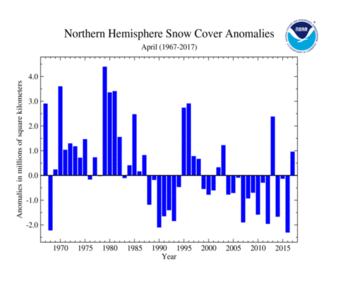NH Snow Cover Extent
| April 2017 | Snow Cover Extent | Anomaly 1991-2020 | Trend per decade | Rank (51 years) | Record | ||||||
|---|---|---|---|---|---|---|---|---|---|---|---|
| million km² | million mi² | million km² | million mi² | million km² | million mi² | Year(s) | million km² | million mi² | |||
| Northern Hemisphere | 31.17 | 12.03 | +1.24 | +0.48 | -0.47 | -0.18 | Largest | 16th | 1979 | 34.61 | 13.36 |
| Smallest | 36th | 2016 | 27.91 | 10.78 | |||||||
| North America | 13.58 | 5.24 | +0.41 | +0.16 | -0.12 | -0.05 | Largest | 21st | 1975 | 15.08 | 5.82 |
| Smallest | 31st | 2010 | 11.02 | 4.25 | |||||||
| Eurasia | 17.59 | 6.79 | +0.83 | +0.32 | -0.35 | -0.14 | Largest | 21st | 1981 | 20.69 | 7.99 |
| Smallest | 31st | 2014 | 14.77 | 5.70 | |||||||
Data Source: Global Snow Laboratory, Rutgers University. Period of record: 1967–2017 (51 years)
The Northern Hemisphere snow cover extent (SCE) during April was 31.17 million square km (12.03 million square miles), 950,000 square km (360,000 square miles) above the 1981-2010 average. This was the 16th largest Northern Hemisphere SCE in the 51-year period of record and largest since 2013. The North American SCE and the Eurasian SCE were above average.
During April, the North American SCE was 540,000 square km (210,000 square miles) above the 1981-2010 average ? the 21st largest on record and largest since 2014. An active storm pattern across the west coast of North America, a late-month storm in the High Plains of the U.S. and lingering snow on the ground from earlier in the season contributed to the above-average snow cover during the month. Above-average snow cover was observed in the Canadian and U.S. Rockies and the Great Lakes. Below-average snow cover was observed in parts of the U.S. Northern Plains and Rockies extending into the southern Canadian Prairies.
The Eurasian April SCE was 17.59 million square km (6.79 million square miles), 420,000 square km (160,000 square miles) above average. This ranked as the 21st largest April SCE for Eurasia and largest since 2013. Above-average snow cover was observed across western Russia and central China. Below-average snow cover was observed for northeastern China and the Alps.
Sea Ice Extent
| April 2017 | Sea Ice Extent | Anomaly 1991-2020 | Trend per decade | Rank (39 years) | Record | ||||
|---|---|---|---|---|---|---|---|---|---|
| million km² | million mi² | Year(s) | million km² | million mi² | |||||
| Northern Hemisphere | 13.75 | 5.31 | -3.98% | -2.51% | Largest | 38th | 1982 | 15.47 | 5.97 |
| Smallest | 2nd | 2016 | 13.68 | 5.28 | |||||
| Southern Hemisphere | 5.44 | 2.10 | -21.73% | +2.88% | Largest | 38th | 2015 | 8.37 | 3.23 |
| Smallest | 2nd | 1980 | 5.40 | 2.08 | |||||
| Globe | 19.19 | 7.41 | -9.78% | -0.75% | Largest | 39th | 1982 | 23.19 | 8.95 |
| Smallest | 1st | 2017 | 19.19 | 7.41 | |||||
Data Source: National Snow and Ice Data Center (NSIDC). Period of record: 1979–2017 (39 years)
According to the National Snow and Ice Data Center (NSIDC), the Northern Hemisphere (Arctic) sea ice extent — which is measured from passive microwave instruments onboard NOAA satellites — averaged for April 2017 was 13.83 million square km (5.34 million square miles), 1.02 million square km (390,000 square miles), or 6.87 percent, below the 1981-2010 average. This tied April 2017 was the smallest April Arctic sea ice extent on record. This is the seventh consecutive month with record-low sea ice extent in the Arctic. The rate of sea ice contraction was fairly even during April with much of the ice loss occurring on the Pacific side of the Arctic in the Bering Sea, Barents Sea and the Sea of Okhotsk with little change on the Atlantic side of the Arctic. April Arctic ice extent is decreasing at an average rate of 2.5 percent per decade.
The April Southern Hemisphere sea ice extent was 6.07 million square km (2.34 million square miles), which was 1.35 million square km (520,000 square miles), or 18.19 percent, below the 1981-2010 average. This was the second smallest April Southern Hemisphere sea ice extent on record and 140,000 square km (50,000 square miles) larger than the record set in 1980. Below-average sea ice extent was observed in the Amundsen Sea, Ross Sea and eastern areas of the Weddell Sea. Above-average sea ice extent was observed in the north-central Weddell Sea.
For further information on the Northern and Southern Hemisphere snow and ice conditions, please visit the NSIDC News page.
 NOAA's National Centers for Environmental Information
NOAA's National Centers for Environmental Information




